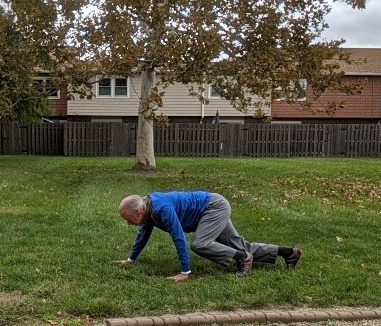
I experimented with animal moves a while back, but for various reasons ended up not getting them added to my broader movement practice. Just recently I’ve been trying them again, and this time they seem to be sticking.
Most of the credit goes to Julie Angel and specifically to her free Move More course, which I highly recommend.
I’ve looked at a lot of free movement courses on the web, and most of them don’t suit me. (A class can work great in person, but a video of that class pretty rarely hits the spot as well, and that’s what a lot of free movement classes tend to be.) Julie’s class is different—better.
Half of this, I suspect, comes down to her being a filmmaker as much as she is a movement coach, so she knows how to use the language of moving images to tell a story (and telling a story is often the best way to teach something). Besides that, this particular class—especially the “animal moves” segment—happened to be just exactly the right level for me.
The animal moves themselves are just names given to perfectly ordinary sorts of quadrupedal ground movement—prone crawling (bear crawl), supine crawling (crab crawl), moving forward or laterally from a squat (frog or ape respectively). Those are mostly useful movements. (Prone crawling for going under something. Supine crawling for going down a steep or slippery slope. I’m not sure how useful frog hopping is by itself, but it’s a progression toward doing kong vaults, so useful for that at least.) Giving them animal names is possibly useful as a memory aid if nothing else. But the whole thing can be taken up a notch by coming up with some transition moves that let you go from one animal move to another, and thereby put them together into a flow, which takes it above just being a useful move and turns it into something more like a dance. An opportunity for self-expression, at any rate.
Various people have come up with such transitions, but until I came across the Animal Moves segment of Julie’s Move More class, I hadn’t found an introduction at the right level for me—everything was either too basic, or else too complex, so I either didn’t learn anything, or else I couldn’t make the jump to actually including the moves as part of my practice.
The three or so animal moves, together with the three or so transitions that Julie teaches come out exactly right. Not too much to learn from a video, but enough that I could go ahead and put together a flow—which means that my training session can be much more interesting than just doing one crawl followed by another followed by another.
Just as an aside, I should mention that the transitions are also useful moves in their own right. They’re not just useful for transitioning from prone to supine crawling, but also useful for things like transitioning from sitting on the ground to standing (and vice versa), or transitioning from one seated position to another.
